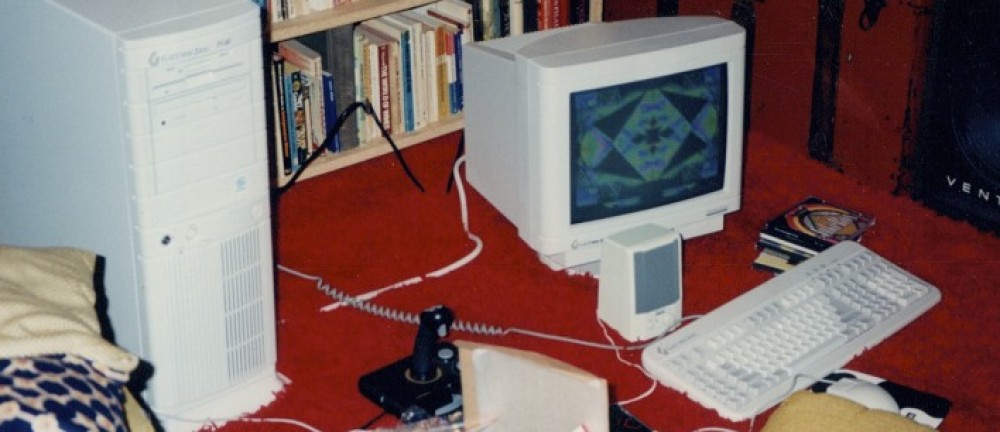I recently returned from the 2013 NAB Expo in Las Vegas. For those who are unfamiliar, the NAB Expo is the biggest trade show and convention for the domestic film and broadcast industry. For one week every year, the Las Vegas Convention Center plays host to 100,000 film, video, and radio professionals, who come to check out the latest gear, learn what’s hot, and just generally hang out with a group of like-minded folks. It’s a “who’s who” of the business, and it’s far more massive than you can possibly imagine.
This was, as best as I can recall, my 12th year attending NAB. Some of those years have been quick hit-and-run visits (fly in in the morning, and out in the evening) and some have been incredibly intense week long affairs, building and manning the booth for Divergent Media. This year was somewhere in the middle – a week in Las Vegas, but only smaller events for the company, and plenty of time to explore the show.
In the aftermath of the show, I’ve been reflecting on the changes I’ve seen, and what it means about the industry.
When I first went to NAB in 2001, there was a sharp divide between the “indie” producer and the professionals. The desktop video revolution was still picking up steam, as DV cameras got better and “affordable” editing software gained pro features. Indie filmmaking involved a lot of clever repurposing, scraping by, and bending rules. Figuring out how to build your own steadicam approximation, repurposing Home Depot lights for your shoot, and assembling firewire drives from bare enclosures to save a few bucks.
There was precious little “prosumer” gear on the market – the pricing model still favored rental houses and big shops. Indies were largely ignored on the show floor. Apple and a few others saw where things were going, but the “big guys” were indifferent or downright disparaging.
Over the following four or five years, the “indie” part of “indie filmmaking” dropped off – everyone was an indie filmmaker, and everyone was a pro. Equipment became much more affordable and much better, software became cheaper, and everyone began to accept the new reality.
This was a particularly exciting time in the industry because we were right on the edge of what technology was capable of. Realtime effects, HD editing, multicam editing – you could see Moore’s Law in action. Each year, the quality of what could be done on a reasonable budget (or done at all) improved immensely.
The bursting of the financial bubble had a big impact on NAB, as it did on every trade show. Attendance dropped, and the pace of innovation slowed. But the bigger change is what began to happen around 2009, and built speed over the following years. The part of the industry we used to call “indie” grew up and became mature, and nothing replaced it to hurl rocks at the old guard. Today, innovation is no longer a matter of “last year that wasn’t possible and now it is,” or “last year this was $10k and now it’s $1k,” but rather “last year that took four steps and now it takes three” or “now it looks 5% better.”
Take, for example, the upstart camera manufacturer Red. Red was the star of the 2006 NAB show – they announced the Red One, a 4K “cinema” camera at a price that indies could potentially afford. They were aiming to disrupt the camera market, and filmmaking in general.
While Red had teething problems, by late 2007 it was a real product and accomplished a lot of what its creators set out to do. People who had been shooting films on $250,000 Sony F950s or actual film cameras began working with this $30,000 rig. Red bet on affordable pixel density, and for a while, they won.
The problem with disrupting a market is that if your competition survives the disruption, you have to compete on an ongoing basis. Now, in 2013, we have 4K (or higher) cameras from every manufacturer, at prices that in some cases substantially undercut Red. There are new kids on the block, like Blackmagic Design. And big vendors like Sony have caught up on pricing, marketing, and features. Whereas Red was once the star of the show, they’re not a bit of an also-ran.
The industry has matured in such a way that it gives filmmakers more choice for lower prices. You can’t pick a bad camera anymore. You can’t pick a bad editor. The industry has caught up with the market it serves. It’s no longer in need of a massive disruption. You don’t need clever tricks or dumpster diving – you just need talent.
It’s not just true in cameras of course – Final Cut Pro disrupted editing, Blackmagic’s revival of Resolve disrupted color correction, the LED revolution disrupted lighting, and obviously distribution is just one long stream of disruption.
The reality is that the film and video industry has grown up, and reached a point of stability. While there may be a new “indie filmmaking” revolution in the future, it doesn’t feel like it’s right around the corner. This is reflected in the NAB Expo. It feels like the demographics are skewing a bit older. I still feel like I’m one of the “young” folks there, even though I’m substantially older than when I first attended. There’s less razzle-dazzle – fewer vendors going to extremes to show up the vendor at the next booth. It’s less circus, less sexy, just business.
